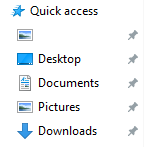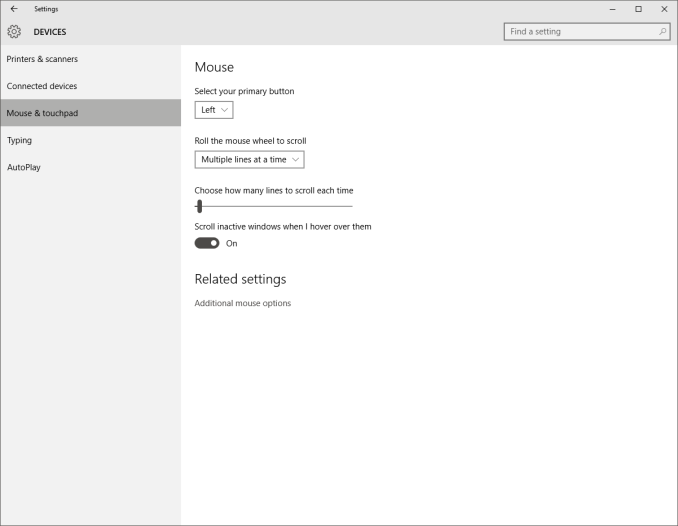The Windows 10 Review: The Old & New Face of Windows
by Brett Howse on August 25, 2015 8:00 AM EST- Posted in
- Operating Systems
- Microsoft
- Windows 10
More Desktop Changes
One of the goals of Windows 10 is to entice Windows 7 users to migrate to the new operating system. The additions we’ve seen already to the traditional mouse and keyboard interface have already been substantial, and should make most Windows 7 users comfortable. But they are not the only changes to the desktop. There is a little bit for everyone, both casual users and enthusiasts alike, so lets check out some more of the new features of Windows 10’s desktop.
Windows 8 changed up Windows Explorer, and brought in the ribbon menu. Office 2007 was the first Microsoft program to move from the file menu to the ribbon menu, and while it was controversial at the time, it is now very familiar. Moving Windows Explorer to a ribbon menu made it both easier to use with touch, as well as exposing settings and features that may have been tucked away in a submenu before. Windows 10 evolves this. Opening up Windows Explorer now greets you with a list of files you have recently accessed in the main pane. The thinking is that when you go to Explorer, you are likely looking for something you’ve used before. I won’t dispute the logic, but I prefer to see the computer view myself. Luckily it’s an easy option to change by clicking File->Change folder and search options. What I do like though is the Quick Access feature in Windows Explorer, which gives you – you guessed it – quick access to folders that are used a lot. The system will automatically add folders you go to frequently which is kind of great for discoverability, and you can add or remove any folder here. I have found it very useful, and since it is also built into the file picker for saving files, it makes it easy to get where I want to go when saving files.
Another nice feature to come to Windows Explorer is the Share contract. Windows 8 introduced contracts, which allow apps to communicate with one another over dedicated protocols, and adding it to Windows Explorer is a great way to expand them from the tablet style apps to the desktop. Share was likely the most useful contract, and I was always disappointed that the Windows 8 Charms did not offer any functionality on the desktop, so this is a great addition.
There are also small changes which improve Windows 10 over Windows 8. Things like having drop shadows back. Windows 8 went for a very flat UI, and it was clean looking but the lack of depth was not very useful with multiple windows open. Adding drop shadows back give the subtle definition around windows to make them stand out a bit more.
One of my favorite features that has come to Windows 10 is the ability to scroll an inactive window. Prior to Windows 10, and assuming you were not running a third party utility which enabled this, in order to scroll a window you had to first select it. Now, you can just move your mouse over any open window and use the scroll wheel to move whatever window you are over. You can do this on windows that are buried three or four deep – as long as you can see some of it you can scroll it. It is great when you are referencing a PDF or site, and writing at the same time, since you can continue to type while scrolling around in your reference document. For those that think this is insane, yes, you can turn it off.
Windows 8 seemed to signal that Microsoft was looking to a future past the desktop. There were some nice changes brought to the Windows 8 desktop but they were overshadowed by the changes brought in by the touch-first UI. With Windows 10, Microsoft is not only trying to bring back the focus on the desktop, they have added a lot of great features as well which should certainly entice users of both Windows 7 and 8.1 to want to switch.














293 Comments
View All Comments
tonytroubleshooter - Wednesday, August 26, 2015 - link
they dont care about licensing it, they care about people installing a "OMG free Win 10 upgrade", with Cortanana and privacy settings enabled. Soon as the number of WIn10 installs with express settings goes up, so will the money stacks from advertisers to MS. for shame MS, for shame... shadowing Google like a biznitch....BobSwi - Tuesday, August 25, 2015 - link
Sticking with 7, and likely next upgrade will be linux with windows in a VM. Virtual box has let me ttest drive so many OS's, Mint, Debian, Slackware.n0b0dykn0ws - Tuesday, August 25, 2015 - link
I know I'll be in the minority, but this OS suffers from the same flaw that Windows 8(.1) did. It offers little reason to upgrade and takes away things that I use.I still use Windows Media Center because it is the most polished modern DVR platform for Windows. Either products were dumped years ago and are only available as their last release, or there are modern platforms that you have to spend vast amounts of time configuring and when it finally does work you have to pray that the next release doesn't break it.
There is a sliver of hope with SiliconDust's forthcoming DVR software, but until it is in final release and I can finally know the final technical details of the platform I am forced to continue using Windows 8.1 on all three of my desktops.
There just isn't enough 'new' in Windows 10 to make it worthwhile jumping ship. Especially given that features such as Cortana I am no longer interested in using.
vLsL2VnDmWjoTByaVLxb - Tuesday, August 25, 2015 - link
One troubling aspect of this ecosystem is I've had trouble using my Microsoft account, including Onedrive, too many times. What is happening right now and for the past few weeks on my work system is a continual prompt to provide credentials when I save documents. It makes getting work done nearly impossible, and I'm considering abandoning this setup I've had for quite some time.Previously I've had issues with syncing and adding extra space to my Onedrive account. All in all it's the heart of much of this ecosystem and I've lost trust in it, and therefore, much of my trust of Windows in general. It's my data, why must you make me struggle to access it?
basroil - Tuesday, August 25, 2015 - link
"Accessing all apps is different than Windows 7 because there are no folders on the Start Menu. Instead there is just an alphabetical list of all apps that you can scroll through."There ARE folders in Windows 10 start menu/screen, I have ~10 of them ranging from Blender to Visual Studio 2015!
Brett Howse - Tuesday, August 25, 2015 - link
I updated the text. Sorry about that I actually was meaning hierarchical folders like Programs->Accessories->System Tools but I see that what I said was not correct. Thanks for pointing it out!AlexIsAlex - Tuesday, August 25, 2015 - link
It's a shame, I really wanted to like Windows 10, and had it pegged as an upgrade from 7. It's certainly an improvement over 8, but I'm just not seeing anything convincing over 7 for a desktop. For the desktop use case (no touch, no wifi, no apps - full applications only please) where I will not accept an MS Account login (no Hello, no Store, no Cortana, no OneDrive), that leaves precious little. Slightly faster file copies and a nicer task manager, it seems.Then there's the new visual look/design language, which I can't say I really like, personally (this is supposed to be client side software, not a website), and the inconsistent UI between Metro and Desktop - seriously, just try right clicking in the start menu (Metro) compared to the task bar (Desktop).
There's Edge I suppose. Better than IE, granted. Not as good as Firefox.
Oh well. I guess we'll all have to migrate eventually. But until forced, I'm sticking with 7.
Victor84 - Tuesday, August 25, 2015 - link
Sums it up pretty well, could not agree more.trparky - Tuesday, August 25, 2015 - link
Firefox? You bring that piece of crap up? That thing will gladly eat through your RAM like a pig. I can't stand Firefox anymore and that goes for anything built on Firefox. The engine itself is garbage. Or, and did you hear that Mozilla will be abandoning XUL and thus all existing extensions will be obsolete?You don't need to tie your Microsoft Live Account to your Windows login if you don't want to. All you need is a Microsoft Live Account and Windows 10 will allow you to individually sign into the Store, OneDrive, etc.
You probably have a Google Account. Same thing, different company.
Oxford Guy - Tuesday, August 25, 2015 - link
Chrome has been linked to issues with memory leakage. I think Chrome is highly overrated.